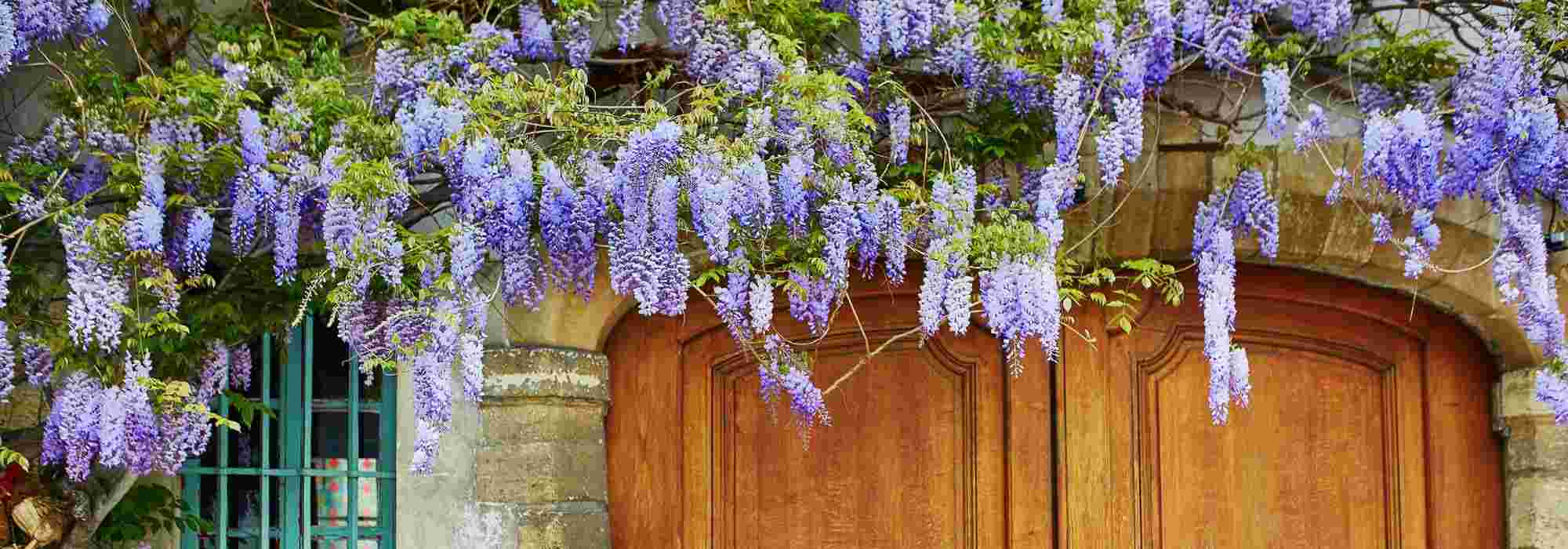
Choosing your wisteria: buyer's guide
Which wisteria for your garden?
Contents
Wisterias (Wisteria by their Latin name), vigorous climbing, dripping with clusters of mauve or white flowers, bring undeniable charm to a garden in spring, and provide welcome shade beneath an arbour in summer! In addition to their abundant spring flowering, which stands out spectacularly on naked wood, these superb, romantic climbing plants, native to China (Wisteria sinensis), Japan (Wisteria floribunda) or America (Wisteria frutescens), exude an exquisite fragrance, among spring’s most intoxicating. Finally, very long-lived and quite hardy, wisterias require relatively easy maintenance.
Unsure which variety to plant in your garden? Choice of support according to vigour, colour and scent, originality, abundance of flowering… we guide you to find the wisteria that will enhance your garden!
Unwavering vigour
Slow-growing at first, wisterias become rapidly vigorous from third year of growth of cultivation, capable of gaining one to two metres in a year.
Trained horizontally as a trellis or pergola, or vertically along a wall facing sun, wisterias have the particularity of attaching themselves to their support thanks to their extremely voluble stems. Their lianas can reach 8 metres in length for Japanese wisteria, and up to more than 10 metres for Chinese wisteria. They wind naturally around a vertical or oblique support. Their vigour is such that they require a very solid support whether a pergola, wire mesh or arbour. It is not uncommon to see damage caused by some mature trunks when support is not strong enough. Consequently, give heightened attention to the support and initial method of fixation, an indispensable prerequisite to the longevity of your wisteria. Be careful not to place it too close to gutters, which it can compress, or to fragile railings that it may even bend.
Exuberant as ever, the Chinese wisteria ‘Alba’ , Wisteria floribunda ‘Alba’, W. floribunda ‘Rosea’ (or ‘Pink Ice’), and W. floribunda ‘Macrobotrys’ easily exceed 10 metres at ripeness.
If, however, you are looking for a wisteria with a more compact habit, because you have a small garden or limited space, American wisteria, Wisteria frutescens ‘Amethyst Falls’ will be an ideal companion. Its reduced growth, with lianas of 5 metres in length and dense, compact purple clusters, naturally predisposes it to colonise confined spaces.
Wisteria venusta ‘Rosea’ will also be a good compromise if you are looking for a less vigorous wisteria. It can even grow in a large container on a terrace. A boon for enjoying the exuberance of this magnificent climbing plant!
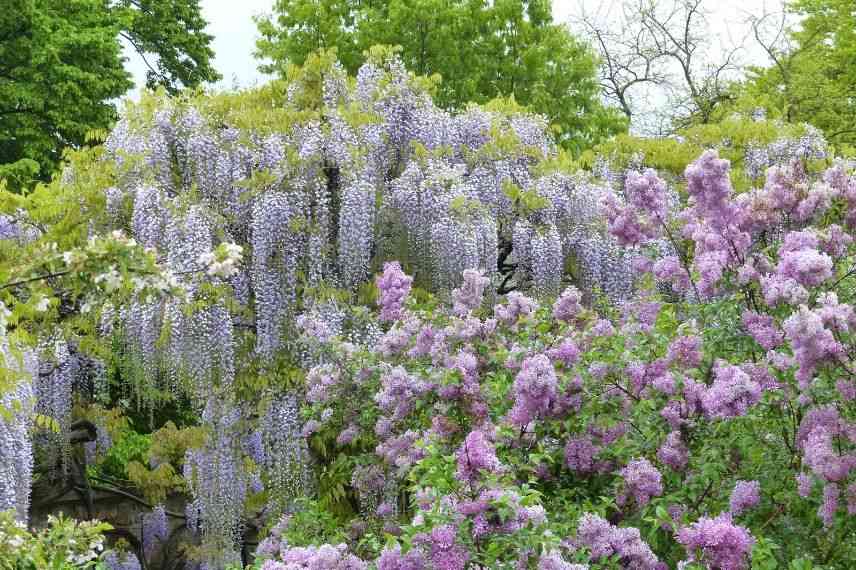
La Wisteria floribunda ‘Macrobotrys’ présente une flowering spectaculaire en longues pendulous clusters !
Read also
Wisteria: how to plant, prune and care?Blue, white, pink… A pastel colour palette
Papilionaceous flowers with corolla gathered in clusters are typical of the family Fabaceae (the well-known ‘legumes’). The type species (botanical) is blue, which is the colour most often seen in gardens and in our imagination. Chinese or Japanese wisteria actually displays three main colourations in its flowers: blue (from mauve to deep violet), pink and white. A tip: buy your Wisteria in flower so you are not disappointed by its colour.
- In blue-dominant colour ranges, some wisterias are darker such as the handsome Wisteria floribunda ‘Royal Purple’. The Japanese wisteria – Wisteria floribunda ‘Macrobotrys’ has spectacular flowers of a lovely purplish-blue.
- Fancy a white wisteria? Choose the Wisteria floribunda ‘Alba’ (also called ‘Shiro Noda’). It is covered in very long white inflorescences, measuring up to 80 cm long, in late spring. Wisteria floribunda ‘Shiro-Noda’ flowers a little later, and therefore tolerates frosts better in colder regions.
- Fancy a pink flowering? Japanese wisteria Wisteria venusta ‘Rosea’ (or ‘Showa Beni’) is covered in pale pink clusters creating a splendid display from late May to early June. The wisteria floribunda ‘Rosea’, less vigorous, is very suitable if you have a small support, or a small garden and wish to enjoy the exuberance of a wisteria. Finally, the wisteria floribunda ‘Honbeni’ is another very elegant variety with soft pink flowers, which will bring much lightness and originality to a sturdy trellis (it will have a spread of about 10 m).

According to flower colour: Wisteria floribunda, Wisteria floribunda ‘Rosea’ and Wisteria floribunda ‘Alba’
Discover other Wisterias
View all →Available in 0 sizes
Available in 0 sizes
Available in 0 sizes
Available in 0 sizes
Available in 2 sizes
Available in 1 sizes
Available in 0 sizes
Available in 1 sizes
Available in 3 sizes
Available in 1 sizes
Deliciously fragrant!
Fragrance is one of the great qualities attributed to wisterias, often sought in this climbing plant commonly seen on pergolas where its scent can be enjoyed. It is always present, but will vary greatly according to variety. Chinese wisteria (Wisteria sinensis) generally offers flowering more fragrant than its Japanese cousin, and provides an incomparable fragrance when standing beneath its trellis!
Number of flowers also affects impression of scent released, and it is indeed during the first spring flowering that the olfactory spectacle is most striking. If this aspect of wisteria is what you favour, do not hesitate to choose one already in flower to better appreciate its fragrance. Finally, bear in mind that the sunniest wisterias exhale the most scent!
Choose without hesitation Chinese wisteria ‘Caroline’ (Wisteria sinensis ‘Caroline’), with clusters of blue-violet flowers: it is without doubt the most fragrant of all. Perpetual, it will bear flowers again in mid-summer, but as with all Chinese wisterias this second flowering will be less intense in scent. In its white form, Chinese wisteria ‘Alba’ will delight the air with its gentle honey scent.
→ Also read: Wisteria, the most fragrant
Be aware, however, that the powerful scent of Chinese wisteria attracts bees fond of its rich nectar!
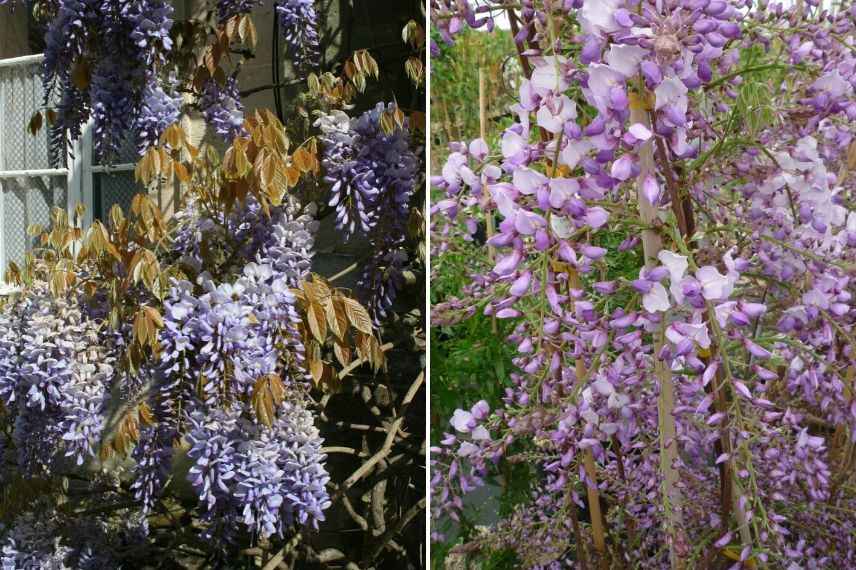
Most fragrant wisterias are Wisteria sinensis, particularly variety ‘Caroline’
Read also
Wisteria: how to train and prune it?Originality of foliage and flowers
Although — apart from their colours and their very attractive soft green compound foliage — they may all seem alike, some wisterias have specificities and even offer very unusual flower shapes or foliage colours!
- Japanese wisteria ‘Violacea Plena’ or Wisteria floribunda ‘Black Dragon’ is one of the rare wisterias with double flowers of blue‑violet, which gives it a truly original appearance. It has the advantage of a very spreading flowering period. It can, for example, be an excellent complement when one already has a wisteria with more ‘classic’ inflorescences.
- Wisteria floribunda ‘Macrobotrys’ has, for its part, some of the longest clusters imaginable, from 80 cm to 1.20 m. It thus creates a sumptuous white curtain, elegant and delightfully romantic.
- Wisteria floribunda ‘Variegata’, with pretty mauve flowers has foliage surprisingly variegated with cream for the genus, and will showcase a slightly shadier spot.
Note that wisteria foliage is attractive in itself: bronze‑green, fresh and luminous at bud burst period (appearance of the leaves), it is highly compound, made up of several small leaflets. It takes on a beautiful golden‑yellow colour in autumn. One final asset: it remains in place for a long time, one of the last to fall before the frosts!
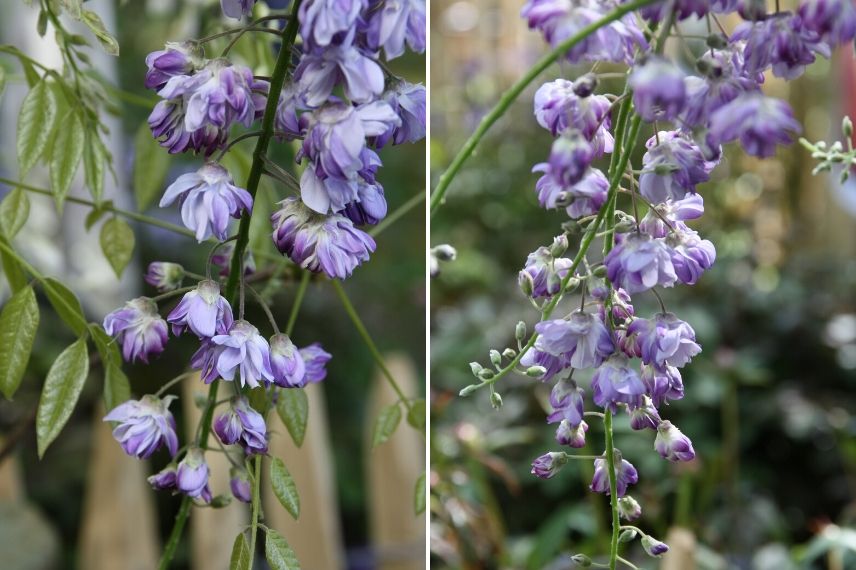
Wisteria ‘Violacea Plena’ or ‘Black Dragon’ offers clusters of double flowers!
Very floriferous varieties
Wisterias flower in late spring, from April through June. Chinese ones flower slightly earlier than Japanese ones, and are therefore a little less hardy. Flowering is long, about 4 weeks, between April and May. Wisteria sinensis is perpetual, meaning it flowers again during the summer, which makes it all the more interesting, although this second flowering will be shorter and less abundant than the first.
Some wisterias stand out for their long clusters of spectacular flowers. Wisteria floribunda (floribunda) is easily recognised by its very long clusters of 30 to 40 cm. It is not uncommon to see clusters measuring up to 80 cm! Its inflorescences are more tapered than those of Wisteria sinensis. It flowers generally for a shorter period than Wisteria sinensis, a little later (May/June) and produces a more compact flowering.
Two varieties are notable for the exuberance of their flowering:
The Wisteria floribunda ‘Macrobotrys’ is a magnificent wisteria with racemes (long pendulous clusters) in blue-lilac. It bears XXL clusters measuring up to 1 metre long, and will make a striking feature in the garden!
Wisteria sinensis ‘Prolific’, aptly named, unfolds graceful flowers white at the centre and lavender from April. This variety has clusters measuring 30 cm that open gradually and allow for a long flowering period.
Remember that all wisterias, Japanese or Chinese, most often flower from the second or third year after planting, while their root system establishes. Patience that is richly rewarded for many years, wisterias having a long lifespan (some are several centuries old in France).
Finally, regarding flowering, note that exposure (at least 6 hours of sun per day) plays a major role in wisteria flowering. Pruning will stimulate flower production, and may even encourage reflowering during the summer.
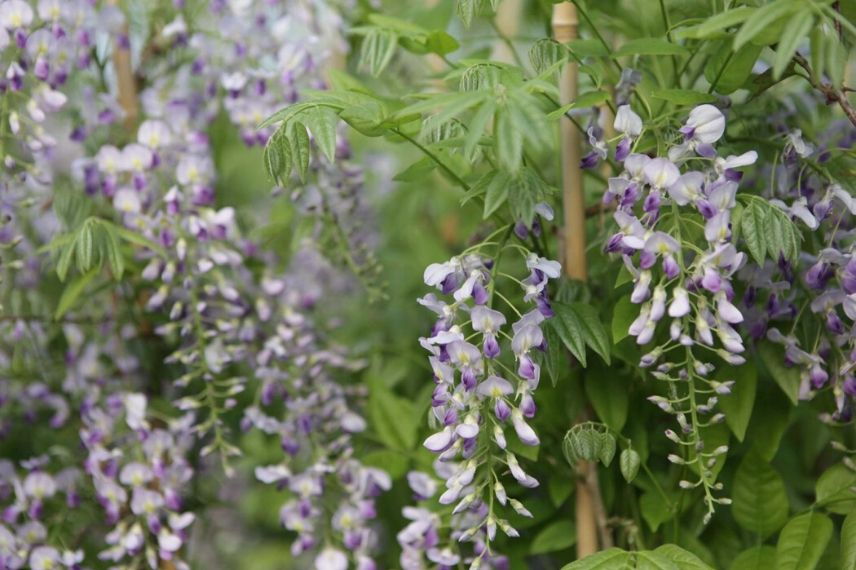
A very floriferous wisteria: Wisteria ‘Prolific’
Discover everything you need to know to plant, prune and maintain your wisteria.
Further reading
- Discover all our tips to grow wisteria in a pot
- Browse our advice sheet: How to pair wisteria?
- Discover 7 early-flowering wisterias with Angélique !
- Which are the most beautiful wisterias to grow in a pot?
- Subscribe!
- Contents
































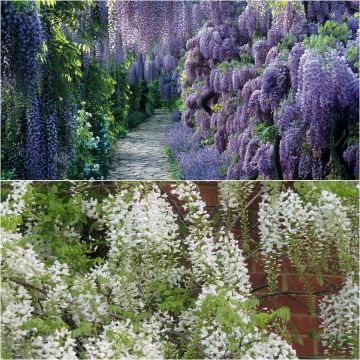
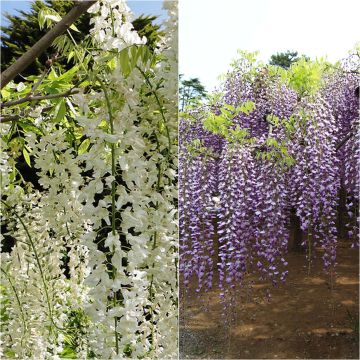
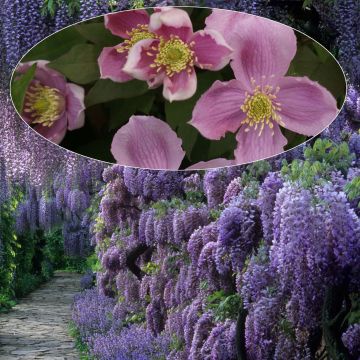
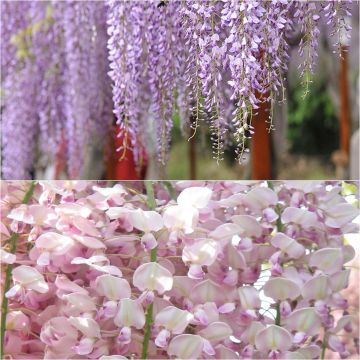
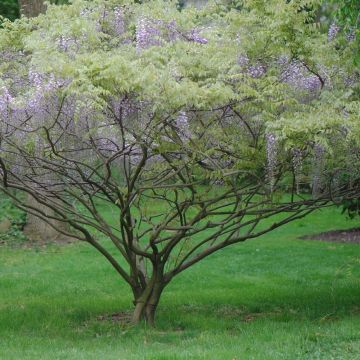

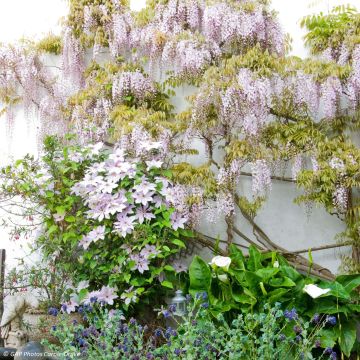

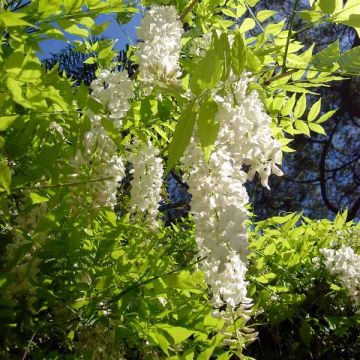
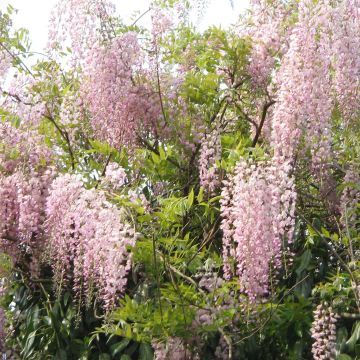
Comments